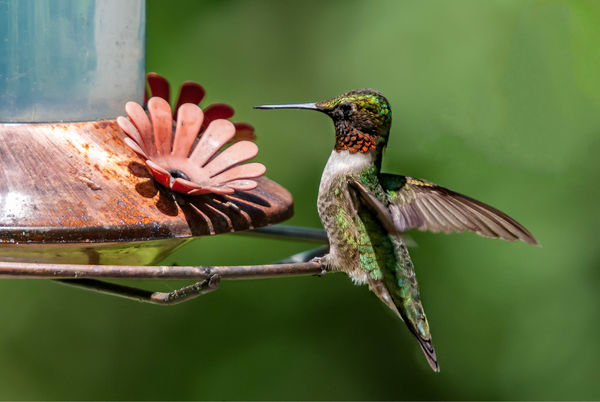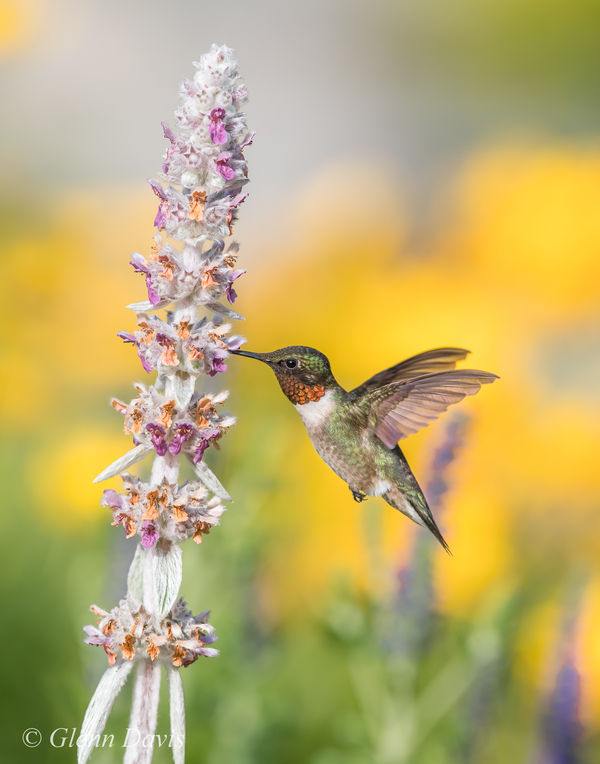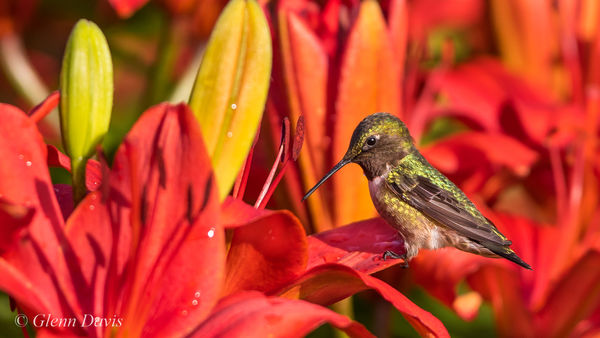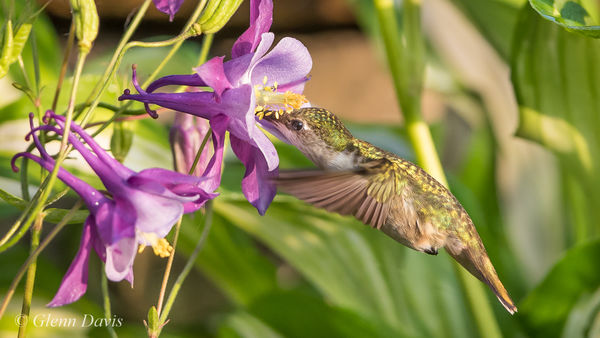Check out Underwater Photography Forum section of our forum.
Shooting Hummingbird
Aug 12, 2018 07:50:01 #
frjeff
Loc: Mid-Michigan
Thought I would set up tripod for my D7200 and Nikkor 70-300 today in an attempt to capture a hummer at our feeder (if one shows up).
Would set camera for Burst and use my wireless remote to trigger shutter. Will be in Manual mode. Will likely set at 300mm.
I’m a real newb so have a few questions:
1) When I set up exposure, should I use Matrix or another setting?
2) I assume the remote will focus pre shutter release using the remote?
3) For focusing, I was thinking single point, but with the rapid movement of this bird and uncertainty where it will be in the frame, what might be a better focus setting?
Thanks to all the UHH helpers on this!
Would set camera for Burst and use my wireless remote to trigger shutter. Will be in Manual mode. Will likely set at 300mm.
I’m a real newb so have a few questions:
1) When I set up exposure, should I use Matrix or another setting?
2) I assume the remote will focus pre shutter release using the remote?
3) For focusing, I was thinking single point, but with the rapid movement of this bird and uncertainty where it will be in the frame, what might be a better focus setting?
Thanks to all the UHH helpers on this!
Aug 12, 2018 08:10:25 #
frjeff wrote:
Thought I would set up tripod for my D7200 and Nik... (show quote)
Manual exposure. Do a few tests, find the right combination, keep it until the light changes. at least 1/2000 sec for the least amount of blur on the wings, then an ISO and aperture to make it work. A max aperture of F5.6 you normally will limit your options, but for adequate depth of field you should try to shoot at F8 or even F11.
Manual Focus. Pre-focus on a point on the feeder that you think the bird is likely to land, and cross your fingers.
An even better approach would be to set up a lawn chair and sit in it for a while. Hummers are not bashful, and once they have identified you as part of the "scene" they will come to the feeder. I have taken pictures of hummers at a distance of around 12 ft.
Aug 12, 2018 08:16:54 #
aphelps
Loc: Central Ohio
frjeff wrote:
Thought I would set up tripod for my D7200 and Nik... (show quote)
Since hummers move unpredictably at high speed I would recommend using manual focusing preset on the feeder. Also manual preset exposure on the feeder. I would use center-weighted metering. Shutter speed of 1/1500 or faster to capture wings in hover. Of coarse that means high ISO to get the exposure right. Take several test shots to dial everything in. Then wait. Sometimes the waiting is the most difficult part. You could also try flash lighting using high speed sync. However, that may spook the hummers. Good luck and be sure to post your results.
Check out Landscape Photography section of our forum.
Aug 12, 2018 08:39:31 #
Aug 12, 2018 17:22:57 #
Aug 12, 2018 19:55:09 #
frjeff wrote:
Thought I would set up tripod for my D7200 and Nik... (show quote)
You don't really need the remote rig. Hummers get used to people who are setting still and will come close.
I sit in a lawn chair about 8 feet from the feeder with my camera in my lap. I remain very still and they come to the feeder with no problem. I raise the camera in a smooth, slow motion and shoot away. I have had them perch or hover less than 3 feet from me and a few nights ago while I was watering the potted plants as I started to wash off one of the feeders (ants - that stuff to keep them away doesn't always work) and refill the anti-ant moat on the top (it doesn't always work either) I had a hummer buzz up, hover about 12-18" from my face and stare at me, then the feeder, then me again "Hey dude, will you wash those *^&%$# ants off the feeder and go away so I can get a drink of nectar?" I have also had two in dispute over the feeder use my head for a racing pylon as they played "chase the birdie". They circled my head so close they went under the brim of my hat and I felt the air on my ear.
camera setting: single point or single point expanded AF, on AI Servo (continuous), spot metering, f/8 to f/16 depending on the light, ISO on Auto with a limit set depending on which body I am using, SS 1/1000 to 1/2000, shutter on silent burst (slower but less attention from the hummers to the slower but quieter mirror flapping away). I will also use high speed sync flash a lot as they are often against the sky and even spot metering can vastly under expose the little guys.
Aug 12, 2018 20:07:55 #
I have a Nikkor 200-500mm lens and for hummingbirds, I tend to set my aperture at its lowest 5.6, shutter at 2500-4000, and set the ISO according to how much light I need. I use single point focus and back button focus, focusing in on the feeder and then moving over to the spot the hummer keeps returning to and hone in from there. I do not use a shutter release but I do use low speed continuous to take several shots in quick succession. I really believe everyone has their own process...but this is what works for me. Enjoy!
Aug 12, 2018 20:24:32 #
I agree with the how to that Gene and others provided. I have two feeders hanging on my front porch. When I go out to shoot I place a potted plant in the vicinity taking note of what the background will look like. Moving the plant a little to the right or left, or even elevating it on a stand can make a difference.
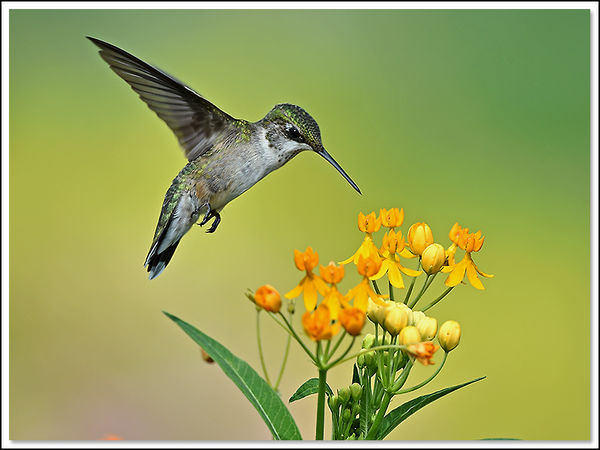
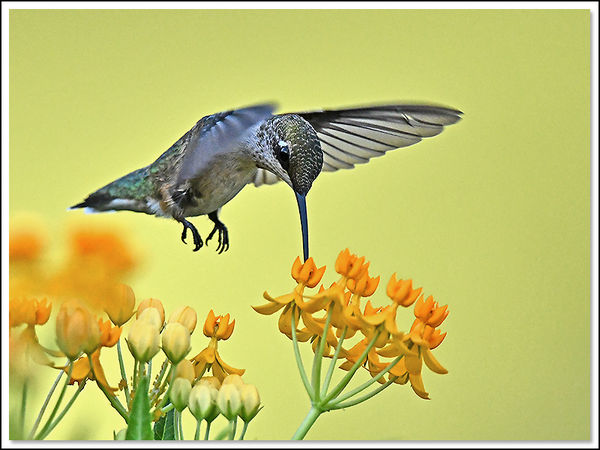
Aug 12, 2018 21:24:09 #
Aug 13, 2018 06:48:34 #
I have to drive to a State park in order to shoot hummers. I use 1/5000 to 1/4000 shutter, auto-ISO and a D810, I also use a SB900 strobe with a Mag mod attached.
Aug 13, 2018 06:53:26 #
Here are a couple of examples of the hummers I shoot. This year the males had already left.

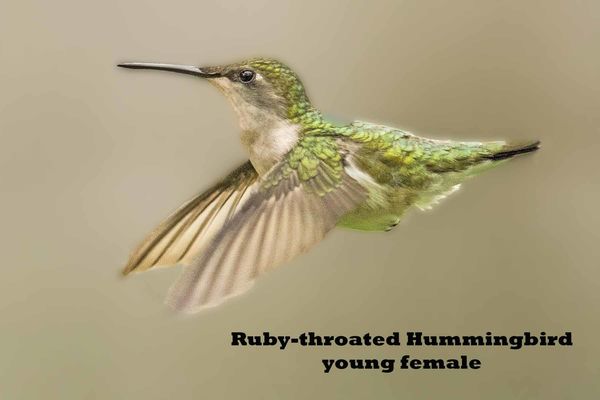
Check out Astronomical Photography Forum section of our forum.
Aug 13, 2018 07:06:37 #
One trick that I like to use is to spray sugar water solution on a particular flower, especially any that are slightly cupped, it will keep them coming back to a specific location and the the sugar water looks like dewdrops or a fresh rain.........
Aug 13, 2018 07:17:56 #
all the folks have given you good advice, not much I can add except it takes time and patience to get the shot you want. Don't be afraid to push the iso up to get the shutter speed you need, at least 1/2000 sec. We put flowers in the vicinity of the feeder to entice them to come there. Single point focus works best for me.
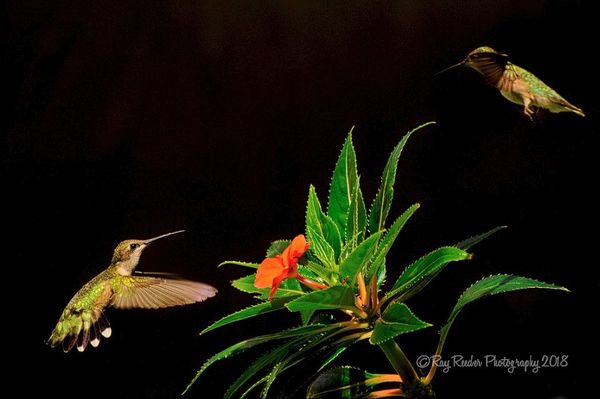
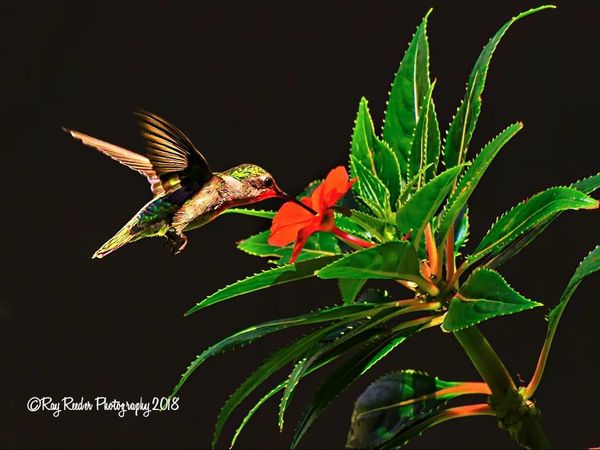
Aug 13, 2018 07:29:47 #
GED
Loc: North central Pa
When shooting hummers in the garden I generally am shooting at f4 and 1/1600th sec to 1/2500th sec and I try to keep the distance within 9 to 18 ft. Just beyond the minimum focusing distance of the lens I am using out to about 18ft so I end up with a decent size file for prints. With the 300mm focal length you could probably focus a little closer than 9ft that was for a 400mm lens. I try shoot when I have enough light to keep the ISO between 320 to 500 to minimize noise. If your hummers tolerate you sitting there in the open WITH your equipment you are fortunate, ours do not. I can sit out there anytime and have hummers two feet away without equipment as soon as they see the equipment they stay away particularly the males. So I have to use a blind which gets very hot. I have tried various techniques and the best for me is to use single spot autofocus, the metering mode I use varies on the backround, if the background is all mostly midtones I will use matrix metering, however if the background is very dark or very bright I will use spot metering. I use aperture priority or manual mode on the camera and always follow the bird and focus on the eye. I do not use a remote for hummers, I believe you will get a much better keeper ratio if you learn to focus on the bird as opposed to prefocusing on a spot and hoping he lands there. Bills method using a potted plant is an excellent one if you don't have gardens to shoot in. I would recommend something red, bee balm and salvia, and many others will pull them in and you can locate the plant to give yourself ideal shooting conditions best backrounds, best light morning and evening. I'll attach a few from this summer using the above method. Best of luck to you they are addicting!
Aug 13, 2018 08:19:31 #
If you want to reply, then register here. Registration is free and your account is created instantly, so you can post right away.
Check out Smartphone Photography section of our forum.

